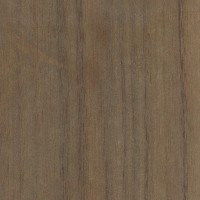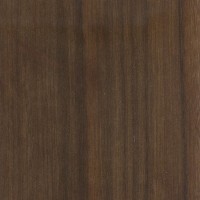 |
Common Name(s): Queensland Walnut, Orientalwood Scientific Name: Endiandra palmerstonii Distribution: Northern Queensland (Australia) Tree Size: 120-140 ft (37-43 m) tall, 4-6 ft (1.2- 1.8 m) trunk diameter Average Dried Weight: 43 lbs/ft3 (685 kg/m3) Specific Gravity (Basic, 12% MC): .53, .68 Janka Hardness: 1,670 lbf (7,380 N) Modulus of Rupture: 14,570 lbf/in2 (100.5 MPa) Elastic Modulus: 1,656,000 lbf/in2 ( 11.42 GPa) Crushing Strength: 9,950 lbf/in2 (68.6 MPa) Shrinkage: Radial: 4.5%, Tangential: 8.6%, Volumetric: 13.1%, T/R Ratio: 1.9 |
Color/Appearance: Ranges from medium pinkish brown to dark brown. Sometimes streaked with pink, greenish gray, or black streaks. Appearance closely resembles English Walnut, though lighter-colored pieces can also resemble Ovangkol.
Grain/Texture: Grain is usually interlocked, and commonly wavy. Texture is medium, with a moderate natural luster, and shallow open pores.
Rot Resistance: Generally regarded as being between moderately durable and non-durable regarding decay resistance. Queensland Walnut is also quite susceptible to insect attack.
Workability: Queensland Walnut can cause troubles in two areas: it can be difficult to plane if there is interlocked grain present, and it has a reported silica content of 0.19% to 1.08%, making it highly blunting to cutting edges. Other than these issues, the wood glues, stains, and finishes well.
Odor: Queensland Walnut does not smell like typical walnut in the Juglans genus: there is no characteristic odor associated with this species when dry.
Allergies/Toxicity: Besides the standard health risks associated with any type of wood dust, no further health reactions have been associated with Queensland Walnut. See the articles Wood Allergies and Toxicity and Wood Dust Safety for more information.
Pricing/Availability: A fairly popular (and common) wood in Queensland, Australia, Queensland Walnut is seldom available in the United States in lumber form, and is likely to be on the expensive side, even for an imported species. Imported veneer sheets are more reasonable priced and are occasionally available in the United States.
Sustainability: This wood species is not listed in the CITES Appendices or on the IUCN Red List of Threatened Species.
Common Uses: Cabinetry, flooring, millwork, furniture, and veneers.
Comments: Even though it’s named Queensland Walnut, and it’s color and appearance would suggest that it is a close cousin to Black Walnut, it actually bears very little botanical relation to the true walnuts in the Juglans genus; the wood isn’t even in the same family as the true walnuts: Lauraceae versus Juglandaceae.
Queensland Walnut is reported to have very good electrical insulation properties, and is favored for some types of electrical enclosure applications in Australia.
None available.
 |
 |





Endgrain picture.
I wouldn’t say that it is very common to find. If i’m not mistaken, most queensland walnut can be only found in forests that are now protected, making it harder and harder to come by these days. Beautiful timber.
Blunting effect is an understatement. No matter how sharp your blades are within a short time on using them on this timber they will go dull. Other than that, the wood is beautiful and everything written about it here is spot on
Lovely species for musical instruments. I used this timber to craft a 14″ x 6.5″ 24 Stave Snare Drum, finished with Danish Oil. The result was absolutely stunning and the sound is as good as any high end custom crafted drum.
Link to hi-res professional photographs of the snare drum…
https://www.dropbox.com/sh/g7gj9sh3tv3yzco/AAC66t8GeCwbpMT1minum2Vta?dl=0
I also used this timber to craft the support frame structure for a Premier Xylophone for the Queensland Symphony Orchestra.
I am Based in Brisbane, Queensland.
It’s also used in musical instruments: My Maton EM325C guitar is Queensland Walnut back and sides.
I have a chest of drawers made of Queensland Walnut, which was manufactured in the 1840’s to 1860’s. It’s a beautiful piece of furniture that I’m proud to own.